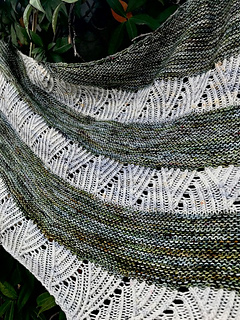patterns >  Moody Knitter Design and 1 more...
Moody Knitter Design and 1 more...
> Edges Shawl

















Edges Shawl
A woodland edge or forest edge is called an ecotone, the transition zone, from an area of woodland or forest to fields or other open spaces.
This point where two different energies meet is the most active part. If we look for it we can bring light into darkness of the forest.
Edges is an elongated crescent shawl, not too large with alternating twist stitch lace and garter stitch stripes in two colors. Optional fringes can add a cozy touch to an otherwise elegant and minimal design. (from “Through the tress, LITLG n°1)
GAUGE after blocking: 24 sts x 44 rows = 10 cm x 10 cm / 4” x 4” in garter stitch. The second sample was worked at a gauge of 20 x 46 rows = 10 cm x 10 cm / 4” x 4” in garter stitch.
Gauge is not critical; different gauge will only affect finished size and yardage (please consider that the second sample required the entire skeins)
FINISHED SIZE after gentle blocking: width 180 cm / 70.75”; depth at the deepest point 38 cm / 15”. The second sample measures width 196 cm / 77”; depth at the deepest point 48 cm / 19”.
MATERIALS
2 skeins of Fingering weight yarn, approx in the following quantity: 366 m / 400 yds for each color (one skein each color).
Yarn used for the first sample (yellow tones): LITLG Single Sock (100% SW Merino) in Flax (Yarn 1) and LITLG Twist Sock (80% SW Merino, 20% Nylon) in Gorse (Yarn 2)
Yarn used for the second sample (green/white tones): LITLG Single Sock (100% SW Merino) in Moorlands (Yarn 1) and Wolf (Yarn 2)
3.25 mm / US 3 straight or circular needle 80 cm / 32” long or longer, or size to obtain gauge (size 3.5 mm / US 4 were used for the second sample)
Stitch markers (optional)
Tapestry needle
Blocking board and pins
Un confine di bosco o di foresta è chiamato un ecotono, la zona di transizione, da un’area di bosco o di foresta ai campi o ad altri spazi aperti.
Questo punto dove si incontrano due energie diverse è la parte più attiva, dove ombra e luce si incontrano.
Edges è uno scialle a mezzaluna allungato, non troppo profondo, con alternanza di sezioni a punto ritorto e strisce a punto legaccio in due colori. Le frange opzionali possono aggiungere un tocco casual ad un design altrimenti elegante e minimale. (da Trhough the trees, LITLG n° 1)
CAMPIONE dopo il bloccaggio: 24 mxx 44 ferri= 10 x 10 cm / 4 x 4” a punto legaccio. Il secondo scialle è stato lavorato ad una tensione di 20 m x 46 ferri= 10 x 10 cm / 4 x 4” a punto legaccio.
La tensione non è vincolante; una tensione differente avrà effetto solamente sulle misure finali e sulla quantità di filato necessario (notare che il secondo scialle ha richiesto la quasi totalità del filato per il colore 1).
MISURE FINALI dopo il bloccaggio: 180 x 38 cm il primo scialle (tonalità gialle); il secondo scialle (verde e bianco) misura 196 x 48 cm.
MATERIALI: Filato di peso fingering in 2 colori, 100 g ciascuno (approssimativamente 366 m/ 400 yds ciascuno).
Filato utilizzato per il campione fotografato: primo scialle (tonalità gialle) LITLG Single Sock (100% SW Merino) in Flax (colore 1) and LITLG Twist Sock (80% SW Merino, 20% Nylon) in Gorse (colore 2); secondo scialle (verde e bianco) LITLG Single Sock (100% SW Merino) in Moorlands (colore 1) and Wolf (colore 2)
Ferri circolari n. 3.25 mm / US 3 lunghi 80 cm/ 32” o più lunghi, o della misura adatta ad ottenere il campione indicato (il secondo scialle è stato lavorato coi ferri 3.5 mm / US 4)
Anellini marcapunto (markers), Ago da lana, Tavola e spilli per il bloccaggio
1004 projects
stashed
1055 times
4772 projects
stashed
6118 times
- First published: February 2020
- Page created: October 26, 2020
- Last updated: November 8, 2021 …
- visits in the last 24 hours
- visitors right now





